Urwerk UR-112 Aggregat: Mechanical Compilation To The Extreme (Plus Video)
Waiting is probably no one’s favorite activity, yet we all have to do it. It comes in all forms throughout the day – and our lives – in drastically different intervals. In the morning, it could be waiting for our toast to get golden brown (time: 3.5 minutes). It could be waiting for a dinner date set for the end of the week (time: 5-7 days).
It could be waiting for the next season of your favorite college football team to start (time: 7 months, 3 weeks, and 4 days). Perhaps you have been waiting for the sequel to your favorite 2009 movie Avatar to hit theaters (time: 13 years, maybe). Or it could be as simple as waiting for the light to turn green while sitting in traffic (time: 120 seconds or less).
But nothing compares to the eternity you experience after you say the words “I love you” for the first time in a relationship. It may take only a second or two, but before you know if they are going to say it back you are frozen in time, and it feels like forever until they start to speak. It turns out Einstein was right: time is truly relative.
So it comes as no surprise that sometimes it can feel like you are waiting ages for a new watch to come out after getting a sneak peak of an unfinished prototype with no solid release date yet.
This doesn’t happen all the time, and I count myself lucky that I get to see behind the curtain sometimes, but it can seem as if so much time is going by while I patiently wait for that really awesome watch to appear and I can finally nerd out about it.
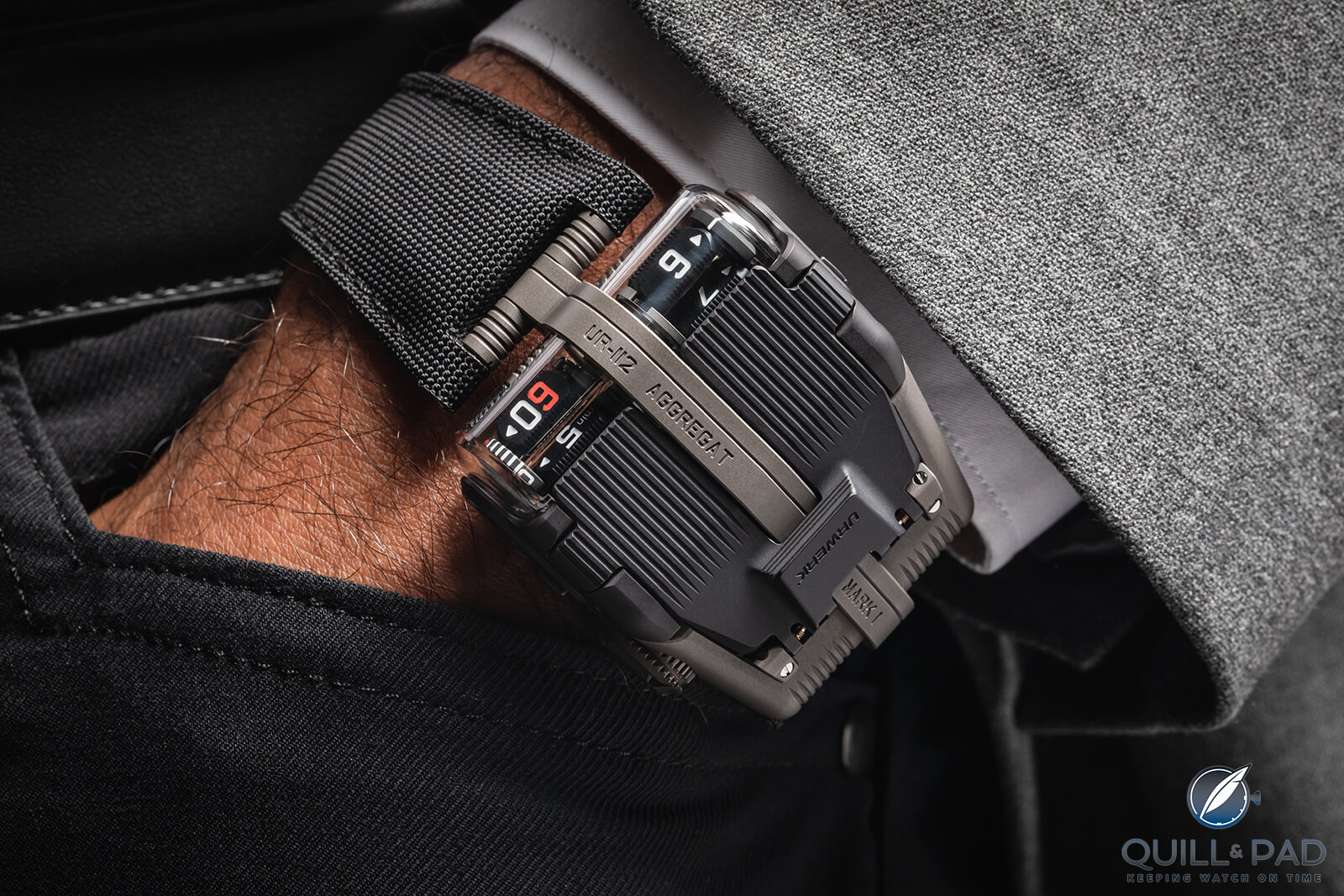
Urwerk UR-112 Aggregat on the wrist
My most recent experience with this was with the Urwerk UR-112 Aggregat, a fantastic new mechanical smorgasbord introducing an evolution of the boutique brand’s developments combined together, hence the German name Aggregat (“aggregate”).

Urwerk UR-112 Aggregat lumed up
Urwerk UR-112 Aggregat
The UR-112 Aggregat is a watch you could say was 25 years in the making as it incorporates features, designs, and mechanics from across the history of Urwerk’s releases. It leans much more into the later years of Urwerk and aesthetically follows the lead of the UR-111C, which itself builds on the 2008 release of the UR-CC1. Mechanically, however, it is a mashup of ideas pulled from multiple models that combined to create new displays and an extremely challenging movement design.
The hours and minutes are displayed on the fore edge of the watch via rotating triangular prisms reminiscent of the early UR-202 and Opus 5. The hours are jumping, set on the four left indicators that cycle three times every 12 hours. The minutes on the right power the hour jump and use the same cycling set of indicator prisms. However, these run continuously and are marked in five-minute intervals. Each number passes by a scale to show the passage of five individual minutes until the next prism starts again.
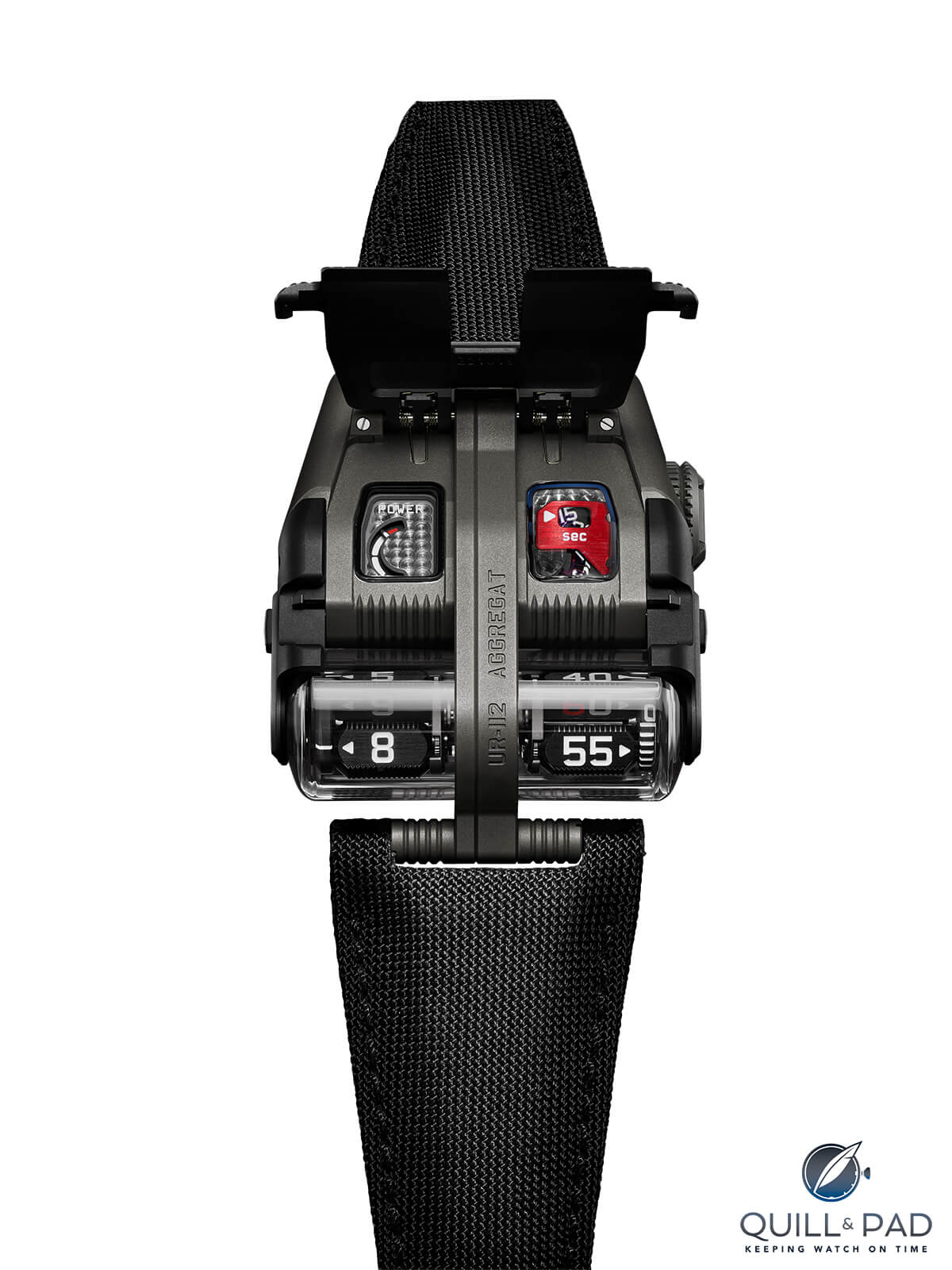
Urwerk UR-112 Aggregat with cover open
The seconds are displayed continuously and in increments of five as well, though this indication is hidden under a hunter-style cover, something seen on previous models of Urwerk’s history. These seconds rest under a magnifying crystal opposite the power reserve above the hour indicators. The watch is split down the middle with a central ridge bisecting the display; this is actually where the case screws together, changing how we might think about case construction.
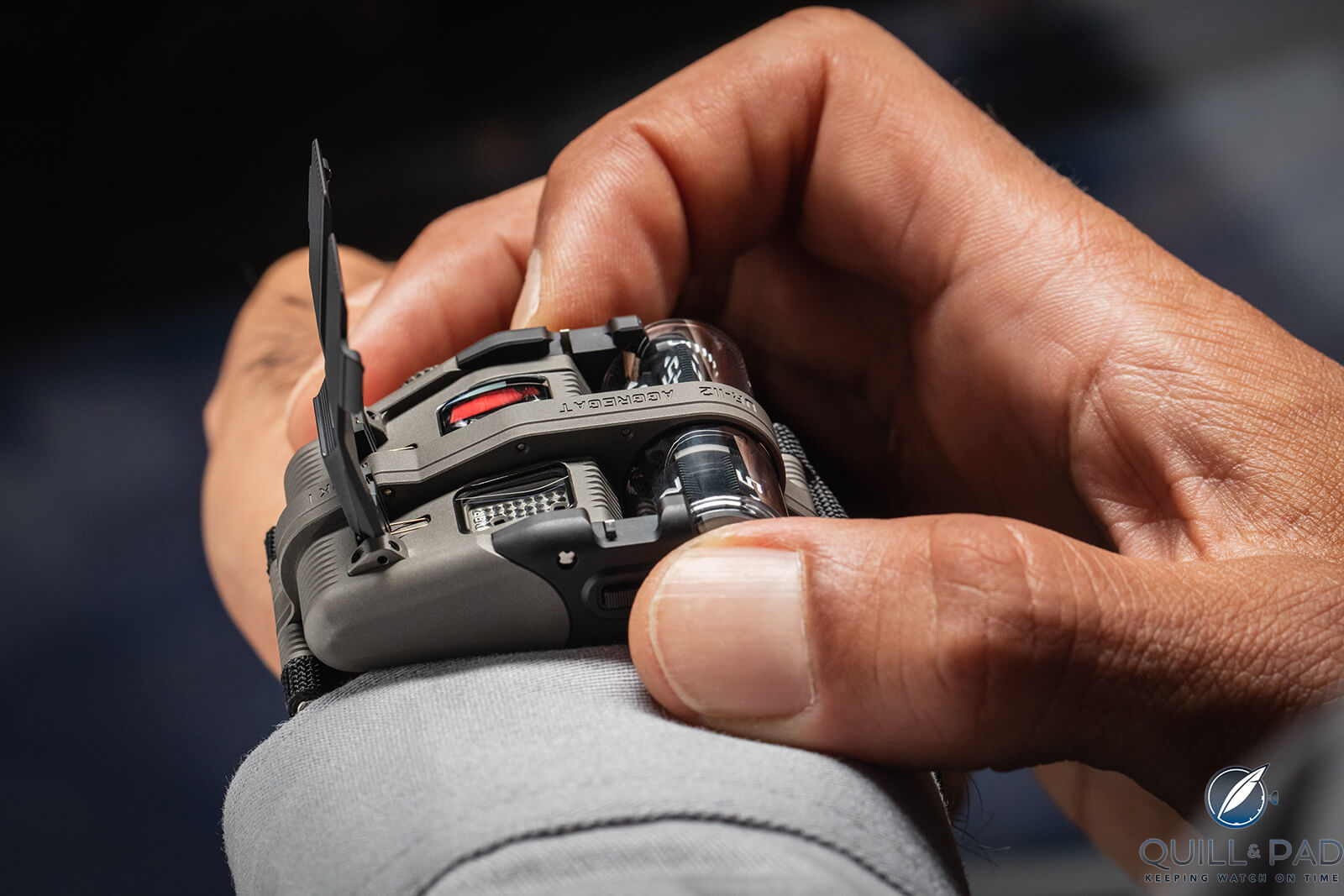
Urwerk UR-112 Aggregat with hunter cover open
The hunter cover is opened by activating two pushers on the side of the case, and winding and time setting is done via a large crown on the right side of the case protruding from the titanium body. The textile strap is secured via T-bar-style attachments that extend off the central ridge, something seen on the UR-111C and functionally similar to how many of the brand’s straps are attached.
The Aggregat is definitely different than anything that has come from Urwerk before yet it feels extremely familiar.
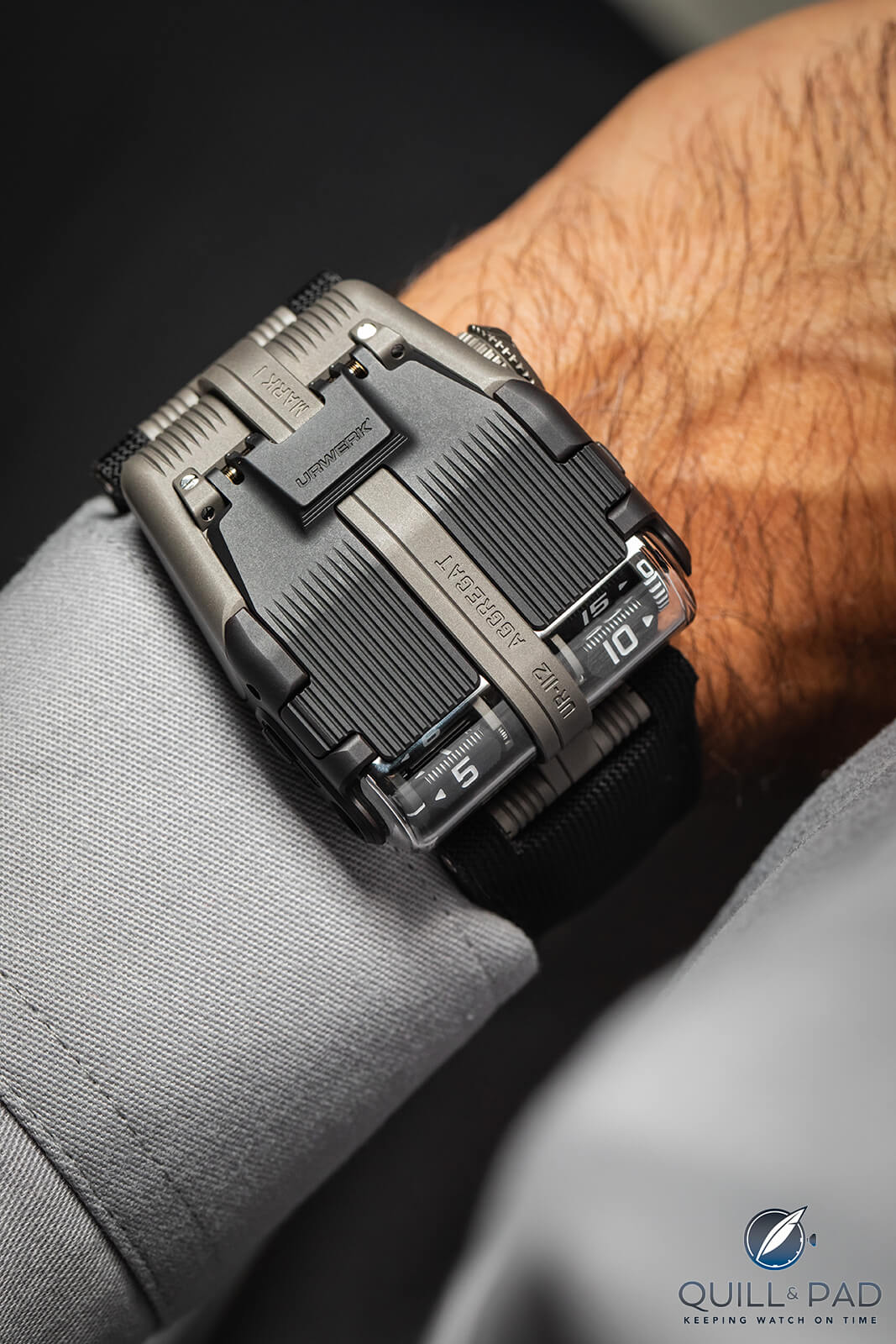
Urwerk UR-112 Aggregat on the wrist
Mechanics and style
The first thing that becomes clear to the longtime Urwerk aficionado is that much of what is in this movement has been preceded by features on other models, but often in an architecture that is fundamentally different. The UR-110 is the most functionally similar mechanism to the hour and minute planetary gear indication on the new UR-112, but in the Aggregat it is turned on its side and read in a different orientation.

Back of the Urwerk UR-112 Aggregat with lume glowing
The theory behind the two mechanisms is somewhat similar but completely different in practice. The rotating prisms are a clear derivation from the decades of rotating cubes on the likes of the UR-110, UR-202, UR-210, UR-220, UR-1001, and Opus 5. But while those had four numbers per cube and three cycling cubes, the triangular prisms here are three-sided and use four prisms more akin to the UR-100, UR-103, UR-105, and UR-106 Lotus, which use four flatter disks that rotate three times.
What’s more, most of these mechanisms use a simple pin and Geneva cross to advance the cubes or disks, but the UR-112 uses planetary gears to keep the prisms aligned as they rotate past the window, then advancing the prisms separately.
The only pieces that use a similar planetary gear system to maintain alignment is the UR-110 and the T8, making this only the third instance of that in the hour display and never has it been used for the minutes like it is here. This brings me to the jumping display, something seen in a handful of places but never like this. In the UR-210/220, 1001, and Opus 5 a retrograde pointer follows the hour indication, while on the UR-CC1 and 111C we have a form of linear minutes indication that also retrogrades to zero at the end of each hour.
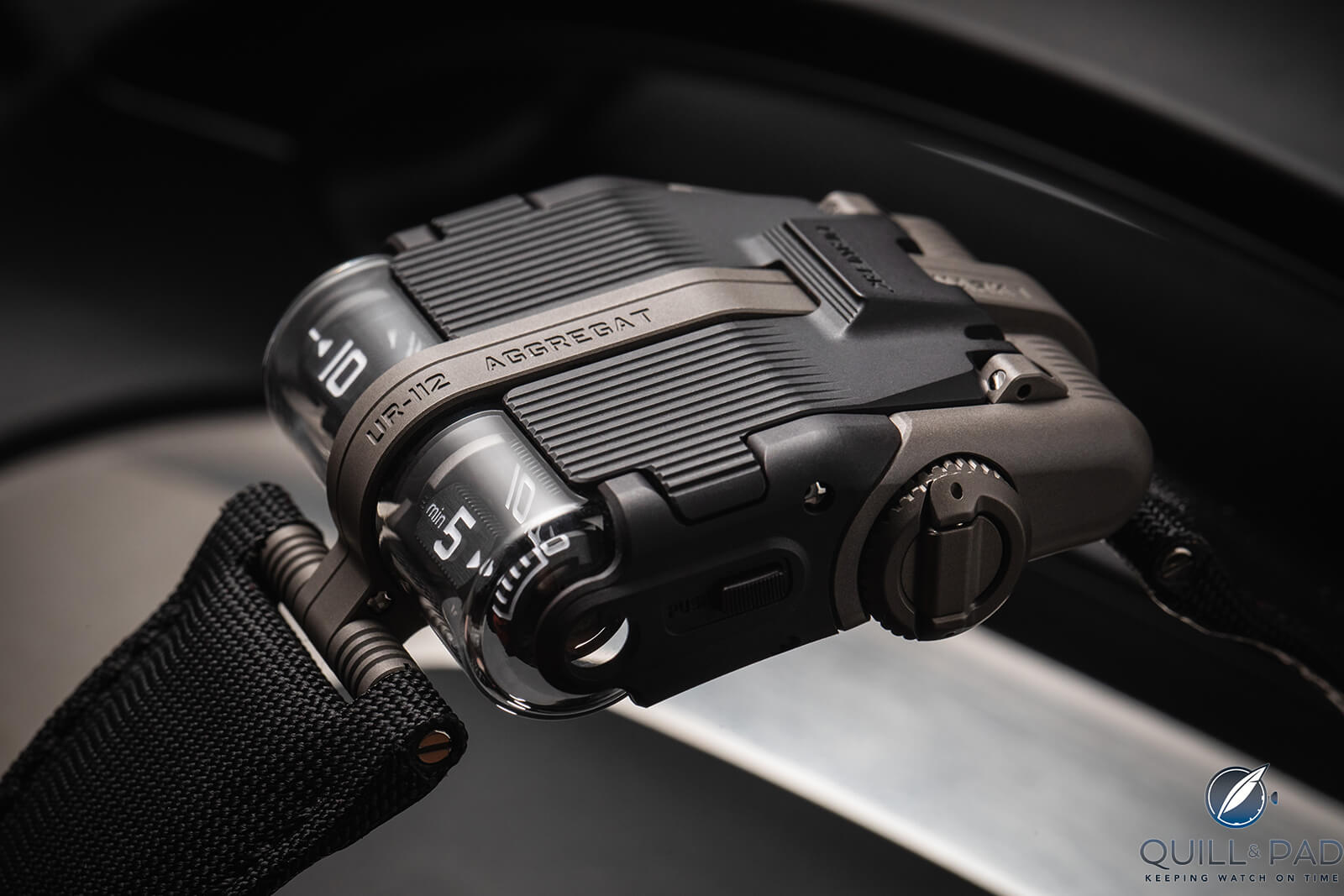
Urwerk UR-112 Aggregat
On the CC1 and 111C the minutes do indeed advance the hour indication with a jump, the closest proximity to the Aggregat, but the UR-112 Aggregat jumps the entire planetary gear system with each hour, the most complicated jump the brand has made yet. On top of that, the UR-112 has some new tricks up its sleeve.
Architecture and new components and mechanisms
The construction of this type of mechanism required some new forms of components that Urwerk has never used before, the prisms on a planetary gear system being a big one. But getting the power from the main part of the movement all the way to the front, where the cantilevered hour and minute displays are located, required a very long driveshaft. This shaft is hidden in the ridge of the case but translates the horizontal rotation of the movement into perpendicular rotation aligned with the case. It then translates that motion around another 90-degree turn to drive the hour and minute displays that are perpendicular to the movement aligned with the crown.
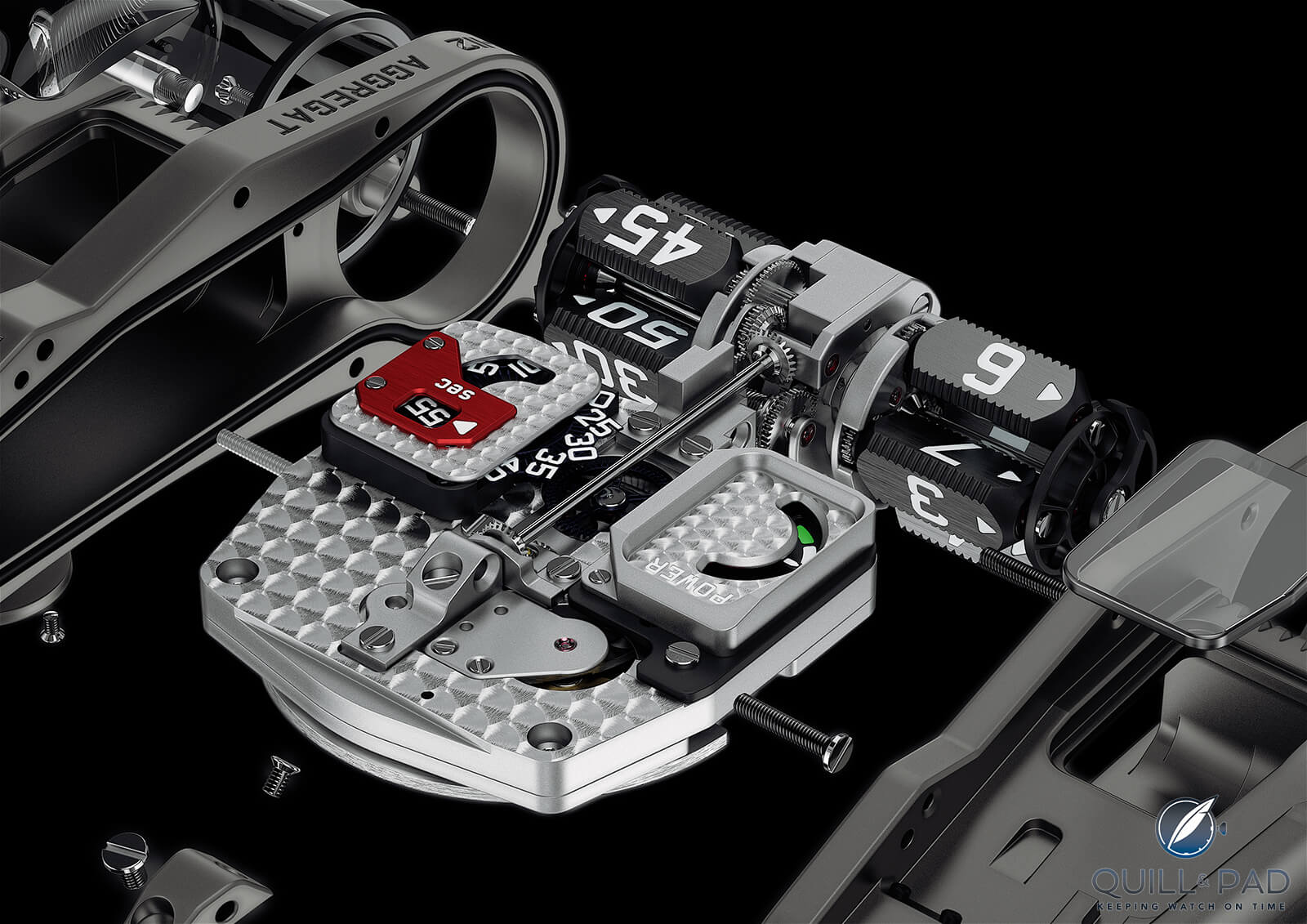
Urwerk UR-112 Aggregat movement
The drive shaft features two bevel gears on each end, and because it changes rotation direction twice the system had to be designed with extra power to overcome the torque loss. While that is sadly hidden, what it drives is not hidden thanks to two large sapphire cylinders completely surrounding the indications. These crystals are protected with extensions to the titanium case, but they fully encase the cantilevered mechanisms to provide an incredible view into the movement.
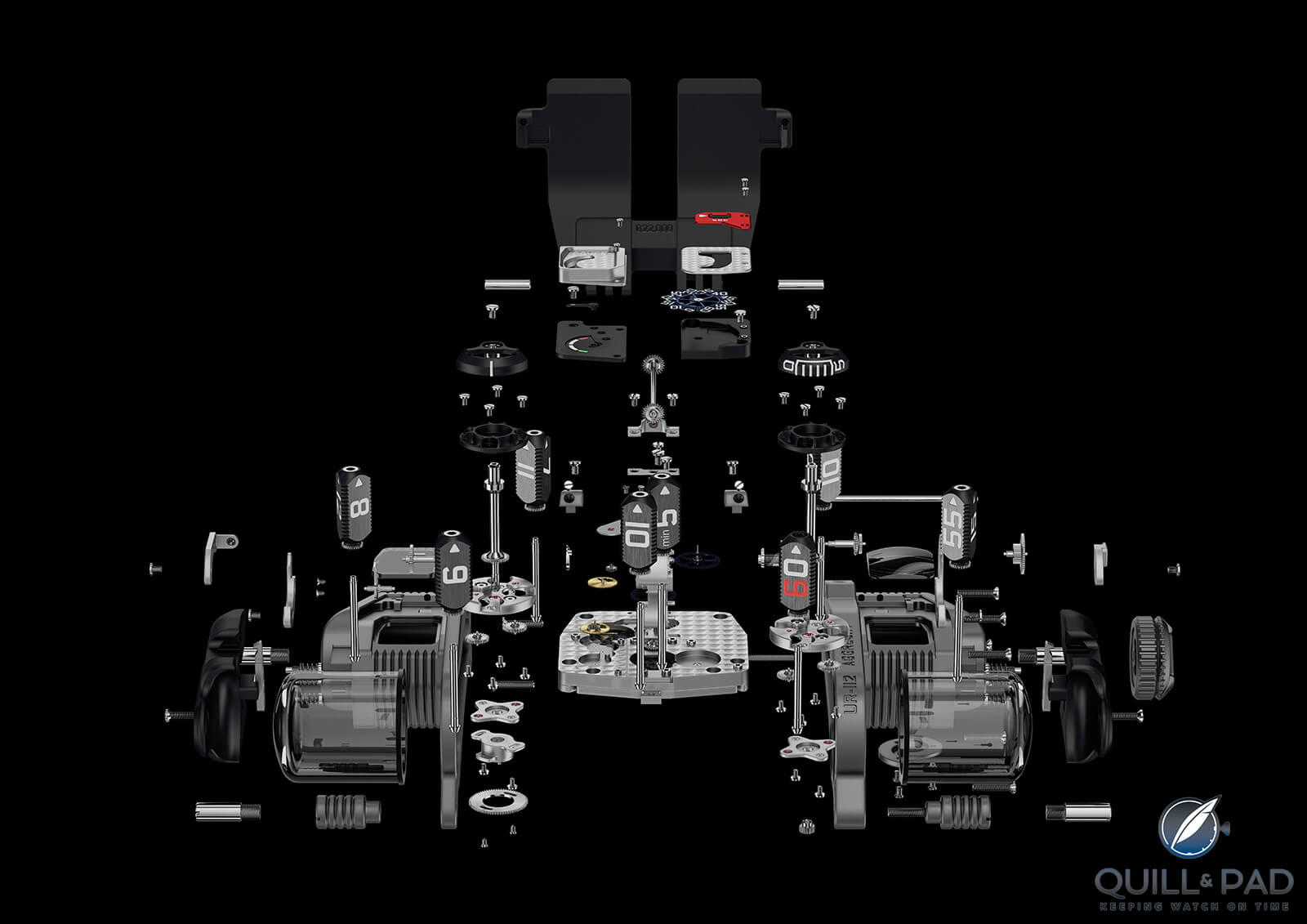
The Urwerk UR-112 Aggregat movement in an exploded view
That assembly method has never been seen before on an Urwerk and only has a few corollaries in the entire industry. It also allows the front of the Aggregat to feel much more like a spaceship (or submarine or Art Deco tank), which, at this point, is exactly the goal that Urwerk is clearly going for with the aesthetic direction. One main repurposed architectural feature is the hunter style-cover, and I love how such a classic and historical idea can feel right at home on such a futuristic piece.
There is nothing about it that feels out of place, and it makes total sense for the aesthetic direction and for expanding the tactile experience of the watch. The name that Urwerk chose for the UR-112 Aggregat is clearly the perfect choice: “a whole formed by combining several (typically disparate) elements” applies in every way to this piece.
No one could say it doesn’t fit perfectly within the Urwerk stable of watches, and yet you cannot say it has a clear predecessor. It is truly a combination, an aggregate of what has come before with a handful of new ideas thrown in. This is why when I first saw the movement during Geneva Watch Days 2021 I was so incredibly excited and why waiting for it to be released and see its final form felt like it took forever.
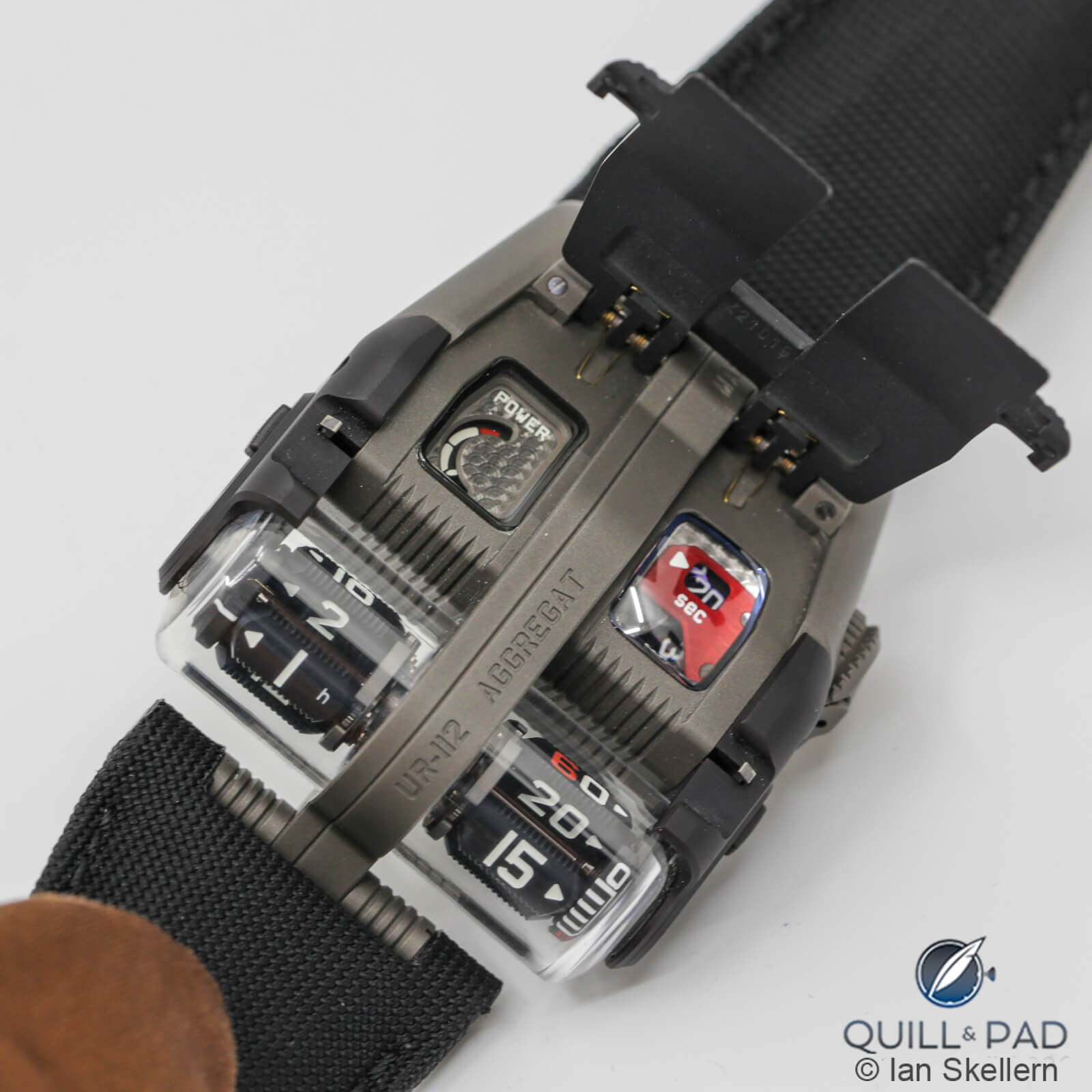
Urwerk UR-112 Aggregat with cover open
The wait was clearly worth it as there is only one thing I would change about this watch: its price. Unsurprisingly, it is well outside of my budget at CHF 250,000, not to mention it is limited to 25 pieces, so the chance to even see one is rare.
I’ll still count it as a win and long for it until the end of my days, or until Felix Baumgartner and Martin Frei decide I should work for them and I can scrabble one together from spare parts!
Until then I’ll just focus on breaking this one down for you!
- Wowza Factor * 9.95 Urwerk is always on the top of my list, and this is high on my list of Urwerk. Just wow!
- Late Night Lust Appeal * 99.5» 975.762m/s2 Two cantilevered planetary gear systems with jump hours and hidden indications? Yes, please!
- M.G.R. * 71 It is stuff like this that got me into watches way back in the beginning, and this is nearly perfect in the ability to geek out about it. Simply amazing movement!
- Added-Functionitis * Mild A power reserve, the quintessential added function for manually wound watches, yet it still only requires children’s strength Gotta-HAVE-That cream!
- Ouch Outline * 13 Stepping on Legos in the middle of the night! Heck, let’s be real: I would run on a treadmill of Legos barefoot if it meant getting this watch on my wrist!!
- Mermaid Moment * What a display! I can’t help but be head over heels for a display and mechanism like that; Urwerk gets me every time!
- Awesome Total * 754.58 Start with the width in millimeters (42) and add the thickness in millimeters (16), then multiply by the caliber number (13.01) and the result is a drool inducing awesome total!
For more information, please visit www.urwerk.com/collections/ur-special-projects/ur-112.
Quick Facts Urwerk UR-112 Aggregat
Case: 42 x 51 x 16 mm, titanium
Movement: automatic winding Caliber UR-13.01, 48-hour power reserve, 28,800 vph/4 Hz frequency
Functions: digital jumping hours, digital minutes, digital seconds; power reserve
Limitation: 25 pieces
Price: CHF 250,000
You may also enjoy:
Urwerk UR-111C: A New Titan Among Titans (Plus Video)
The Urwerk Opus 5 For Harry Winston That Almost Was
Urwerk UR-100V P.02 For Collective: Collaboration And Exclusivity Dock In Space
Leave a Reply
Want to join the discussion?Feel free to contribute!



I cannot understand why such effort would be made to produce two tiny numbers.
Talk about missing the point!
It is the “Rube Goldberg machine” nature of watches like this ,that is the very thing that brings the big bucks ! These are silly, the rich people that buy them are silly. Simple.
The same might be said about any mechanical watch Ray, nobody needs to spend more than $20 on a watch to reliably tell the time, and time now is so ubiquitous on other devices, even $20 on a watch is an unnecessary luxury. How much to spend then is just a question of desire and disposable income. The rich are no different than everyone else, just richer.
Regards, Ian
$20 is too low. I’d say around $500 would get you a watch that would be acceptable to almost anyone who is not a snob.
Its an automatic movement.
Thank you Arnulf, that’s been corrected.
Regards, Ian